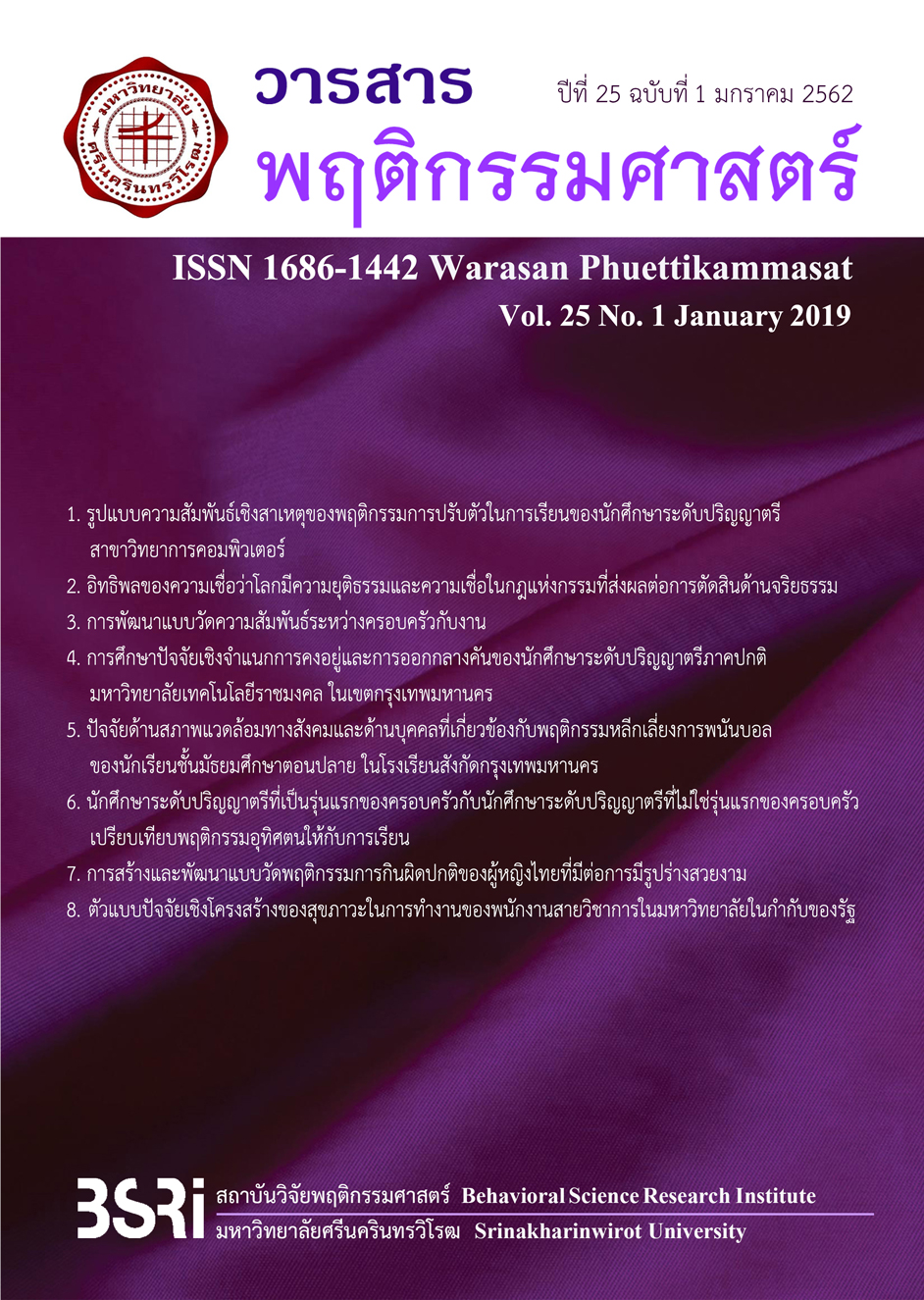การศึกษาปัจจัยเชิงจำแนกการคงอยู่และการออกกลางคันของนักศึกษาระดับปริญญาตรี ภาคปกติ มหาวิทยาลัยเทคโนโลยีราชมงคล ในเขตกรุงเทพมหานคร
Keywords:
persistence and dropout, Rajamangala University, goal commitment, self-efficacyAbstract
The purposes of this research was to study discriminant factors of students’ persistence and dropout and to create predictive equation persistence and drop out of regular program undergraduate students at Rajamangala University of Technology in Bangkok ,Rajamangala University of Technology Krungthep and Rajamangala University of Technology Phra Nakhon. The samples were 695 regular program undergraduate students code 60 including 572 students’ persistence and 123 students’ dropout by proportional stratified random sampling. The instrument for collecting data is 6 rating scales, face validity values ranged from 0.67 – 1.00, the discriminative power from 0.26 – 0.80 and reliability of 0.97. The variables studied include Tinto’ model (academic integration, social integration, goal commitment and institutional commitment) and Bean and Eaton’ model (self-efficacy theory and coping behavior theory). Data were analyzed by Logistic regression analysis. The research found that discriminant factors of students’ persistence and dropout at the .01 level were goal commitment and self-efficacy and logistic regression equation as follows:
log(Odds) = -3.752 + .098(goal commitment) + .084(self-efficacy)
This formula correctly predicted overall success rate of 82.40, where by correctly predicted 98.80 percent of the group of persistence and correctly predicted 6.50 percent of the group of dropout.
References
ก. หน้า 1-23 สืบค้นจาก https://www.moe.go.th/moe/nipa/ed_law/p.r.g.edu1.pdf
บุรทิน ขำภิรัฐ. (2556). ยุทธศาสตร์และระบบบริหารเพื่อการธำรงนักศึกษา มหาวิทยาลัยเทคโนโลยีสุรนารี.
รายงานวิจัยสถาบัน. นครราชสีมา: มหาวิทยาลัยเทคโนโลยีสุรนารี. สืบค้นจาก
https://sutir.sut.ac.th:8080/sutir/bitstream/123456789/5868/2/Fulltext.pdf
วิชชพร เทียบจตุรัส. (2559). การรับรู้ความสามารถของตนเองด้านการเรียนของนักศึกษาชั้นปีที่ 1 คณะ
เทคโนโลยีสื่อสารมวลชน มหาวิทยาลัยเทคโนโลยีราชมงครพระนคร. สืบค้นจาก
https://repository.rmutr.ac.th/bitstream/handle/123456789/673/rmutrconth_27.
pdf?sequence=1&isAllowed=y
สุธี โรจน์บุญถึง. (2559). บทวิเคราะห์ทางวิชาการ เรื่อง ความสูญเปล่าทางการศึกษา. สืบค้นจาก
https://suthee9.com/บทความวิชาการ/item/20-บทวิเคราะห์ทางวิชาการ เรื่อง-ความสูญเปล่าทาง
การศึกษา.html
สุมาลี สังข์ศรี และคณะ (2555). แนวทางการส่งเสริมการคงอยู่ของนักศึกษาทางไกล: กรณีศึกษา
มหาวิทยาลัยสุโขทัยธรรมาธิราชและมหาวิทยาลัยเปิดแห่งประเทศมาเลเซีย. วิจัยสถาบัน กรุงเทพฯ:
มหาวิทยาลัยสุโขทัยธรรมาธิราช.
สำนักงานคณะกรรมการการอุดมศึกษา. (2557). คู่มือการประกันคุณภาพภายใน ระดับอุดมศึกษา ฉบับปี
การศึกษา 2557. กรุงเทพฯ: สำนักมาตรฐานและคุณภาพการศึกษา.
อรอุมา บัวทอง. (2558). ความสัมพันธ์ระหว่าง การรับรู้ความสามารถของตนเอง การกำหนดเป้าหมาย บุคลิกภาพ
เชิงรุก กับประสิทธิผลในการทำงาน ของพนักงานสถาบันการเงินแห่งหนึ่งในกรุงเทพมหานคร. (วิทยานิพนธ์
ปริญญามหาบัณฑิต). มหาวิทยาลัยธรรมศาสตร์, คณะศิลปศาสตร์, สาขาวิชาจิตวิทยาอุตสาหกรรมและ
องค์การ. สืบค้นจาก
https://ethesisarchive.library.tu.ac.th/thesis/2015/TU_2015_5606035490_4476_2609.pdf
อลงกรณ์ ประกฤติพงศ์. (2559). การเพิ่มพันธะภาระต่อการศึกษาเพื่อลดการออกกลางคันของนักศึกษาปริญญาตรี
คณะวิศวกรรมศาสตร์: การวิเคราะห์ปัจจัยเชิงสาเหตุด้วยโมเดลสมการโครงสร้าง. (วิทยานิพนธ์ปริญญา
ดุษฎีบัณฑิต). จุฬาลงกรณ์มหาวิทยาลัย, ภาควิชานโยบาย การจัดการและความเป็นผู้นำทางการศึกษา,
สาขาวิชาอุดมศึกษา. สืบค้นจาก
https://cuir.car.chula.ac.th/dspace/bitstream/123456789/54860/1/5484258227.pdf
อัมพิกา สุนทรภักดี. (2559). การรับรู้การสนับสนุนจากองค์การ การรับรู้ความสามารถของตนเองด้านอาชีพ และ
ผลการปฏิบัติงานของพนักงานขายในธุรกิจประเภทอาหารและเครื่องดื่มแห่งหนึ่ง โดยมีการยึดมั่นต่อ
เป้าหมายเป็นตัวแปรสื่อ. (วิทยานิพนธ์ปริญญามหาบัณฑิต). มหาวิทยาลัยธรรมศาสตร์, คณะศิลปศาสตร์,
สาขาวิชาจิตวิทยาอุตสาหกรรมและองค์การ. สืบค้นจาก
https://ethesisarchive.library.tu.ac.th/thesis/2016/TU_2016_5606035508_5168_4017.pdf
Bandura, A. (1994). Self-efficacy. Retrieved from
https://www.uky.edu/~eushe2/Bandura/Bandura1994EHB.pdf
Bean John P. and Eaton Shevawn B. (2000). A Psychological Model of College Student Retention. J.M.Braxton(Ed.), Reworking the student departure puzzle. Nashville: Vanderbilt University Press.
Bean and Metzner. (1985). A Conceptual Model of Nontraditional Undergraduate Student
Attrition. Review of Educational Research. 55(4): 485-540.
Cabrera, A.F; Nora A; & Castaneda M.B. (1993). College Persistence: Structural Equations Modeling Test
of an Integrated Model of Student Retention. Journal of Higher Education. 64(2): 123 – 139.
Donald W. Fry. (2010). Models of College Persistence Intentions. University of Oklahoma.
(Doctoral dissertation). University of Oklahoma, Department of Education Leadership
and Policy Studies.
Fumei Weng; France Cheong; and Christopher Cheong. (2010). Modelling IS Student Retention in
Taiwan: Extending Tinto and Bean’s Model with Self-Efficacy. ITALICS 9(2): Nov 2010.
Joseph F. Hair Jr., William C. Black., Barry J Babin and Rolph E. Anderson. (2014). Multivariate
Data Analysis. Retrieved from https://is.muni.cz/el/1423/podzim2017/PSY028/um/_Hair_-_Multivariate_data_analysis_7th_revised.pdf
Locke E, A. and Latham G. P. (1990). A Theory of goal setting and task performance. Englewood
Cliff, New Jersay: Prentice-Hall.
Munro B. H. (1981). Dropouts from higher education: Path Analysis of a National Sample.
American Educational Research Journal. 18(2). 133 – 141.
Pascarella. (1980). Student-faculty informal contact and College Outcome. Review of
Educational Research, 50(4): 545-595.
Stenfanie T. B., Barry S. M. and Francesca M. P. (2016). Intent to Persist in College Freshmen: The
Role of Self-Efficacy and Mentorship. Journal of College Student Development, 57(5): 614-619.
Tinto V. (1975). Dropout from Higher Education: A Theoretical Synthesis of Recent Research.
Review of Educational Research, 45(1): 89-125.
Yamane Taro. (1967). Statistics : an introductory analysis. New York: Harper.
Downloads
Published
How to Cite
Issue
Section
License
Behavioral Science Research Institute, SWU
114 Sukhumvit 23, Bangkok 10110, Thailand.
Tel.02-649-5000 # 17600


